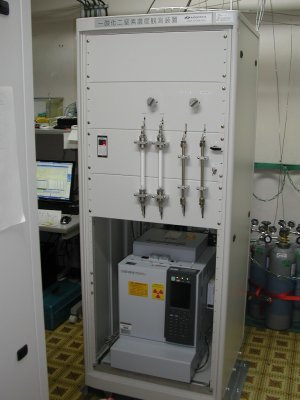Atmospheric nitrous oxide observation
Analyzer
Atmospheric nitrous oxide (N2O) concentrations are observed using a gas chromatograph (GC) equipped with a radiative electron capture detector (ECD) . The GC-2014 system model (Shimadzu Corporation; Figure 1) is used for this purpose at Ryori.
|
Table 1: N2O observation system at Ryori |
Air sample collection and analysis
Air samples are continuously fed into the observation area from the same intake used for CFC observation at a height of about 7 m above ground level. The observation system feeds an air sample into a 3-mL sample tube once every hour and sends it to the analyzer. The composition to be observed (i.e., N2O) is separated by introducing the sample into a column (300 cm of PorapakTMQ 80-100 mesh and 100 cm of PorapakTMQ 80-100 mesh) . Four working standard gases are measured every eight hours. It takes 15 minutes to measure each gas, or one hour in total for all four gases.
Determination of concentration
The outputs for the air samples are converted into concentration values at Ryori observation station using a quadratic calibration curve determined for each measurement cycle based on the known concentrations of the working standard gases and the corresponding outputs. Four working standard gases (natural air-base types) with concentrations matching those of ambient air are used. Their concentrations are determined accurately before use by calibration against JMA's standard gases with a GC-based N2O calibration system at JMA Headquarters (see Calibration for atmospheric nitrous oxide observation ) . To minimize errors caused by temporal variations in the response of the analyzer, two concentrations are calculated using two calibration curves before and after air sample measurement. These two values are then time-interpolated to determine concentration for every hour.
A target gas with concentrations matching those of ambient air is measured once for each calibration curve to monitor long-term variations in the working standard gases as well as any possible anomalies in the observation system.
The working standard gases are also analyzed again at JMA Headquarters with
JMA's standard gases are calibrated against the WMO reference standard gases maintained by NOAA/ESRL, which allows the direct comparison of concentration data collected at stations with those from locations in other countries where the WMO reference standard gases are used.
Background data selection and statistics
The selection procedure for background data is the same as that for atmospheric CFCs (see Atmospheric halocarbon observation ) . The prescribed threshold for N2O is 10 ppb.
